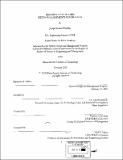| dc.contributor.advisor | Eric Rebentisch. | en_US |
| dc.contributor.author | Wirthlin, Joseph Robert, 1970- | en_US |
| dc.contributor.other | System Design and Management Program. | en_US |
| dc.date.accessioned | 2005-09-27T20:57:51Z | |
| dc.date.available | 2005-09-27T20:57:51Z | |
| dc.date.copyright | 2000 | en_US |
| dc.date.issued | 2000 | en_US |
| dc.identifier.uri | http://hdl.handle.net/1721.1/29158 | |
| dc.description | Thesis (S.M.)--Massachusetts Institute of Technology, System Design & Management Program, 2000. | en_US |
| dc.description | Vita. | en_US |
| dc.description | Includes bibliographical references (p. 291-299). | en_US |
| dc.description.abstract | An idealized process framework for the front-end of product development was developed. The framework covers the process space from an initial need (or recognition of a need) to the decision for a product/development program launch. The framework focuses on the activities required for the development of requirements needed for a business case decision. The framework was developed through a thorough examination of the literature relating to product development and addresses not only the activities required to traverse the front-end of product development, but also metrics and a process maturity matrix by which an organization's process can be evaluated. Using case studies of the front-end processes of eight commercial organizations and eight military organizations in addition to the US Air Force, the applicability of the framework was tested. All of the organizations demonstrated the existence of the four fundamental activities contained in the framework but a discussion of the existing process enablers revealed various interpretations of required features. The maturity matrix was used to evaluate each of the organizations (commercial and military) relative to an idealized and mature front-end process. The analysis revealed a significant gap between commercial and military process performance. Additionally, the existence and application of the process enablers was significantly correlated with the organization's performance in the four process activities of the front-end framework. The implications of the research indicate that military organizations in general will need to reevaluate the current practices in the front-end and the application of process enablers within their organizations. Further, military organizations should reexamine if the current process structure for system development in the front-end needs significant changes. | en_US |
| dc.description.statementofresponsibility | by Joseph Robert Wirthlin. | en_US |
| dc.format.extent | 299 p. | en_US |
| dc.format.extent | 26261426 bytes | |
| dc.format.extent | 26261184 bytes | |
| dc.format.mimetype | application/pdf | |
| dc.format.mimetype | application/pdf | |
| dc.language.iso | eng | en_US |
| dc.publisher | Massachusetts Institute of Technology | en_US |
| dc.rights | M.I.T. theses are protected by copyright. They may be viewed from this source for any purpose, but reproduction or distribution in any format is prohibited without written permission. See provided URL for inquiries about permission. | en_US |
| dc.rights.uri | http://dspace.mit.edu/handle/1721.1/7582 | |
| dc.subject | System Design and Management Program. | en_US |
| dc.title | Best practices in user needs/requirements generation | en_US |
| dc.type | Thesis | en_US |
| dc.description.degree | S.M. | en_US |
| dc.contributor.department | System Design and Management Program. | en_US |
| dc.identifier.oclc | 45425494 | en_US |
